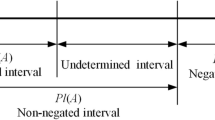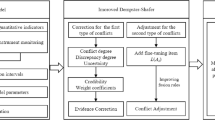Abstract
The tunneling collapse is the main engineering disaster during tunnel construction by the drilling and blasting method. It has become a key issue to accurately evaluate the tunneling collapse risk. As for assessing the tunneling collapse risk and providing basic risk-controlling strategies, this research proposes a novel multi-source information fusion approach that combines the cloud model (CM), the support vector machine (SVM), and the evidence-based reasoning (ER). In the data processing phase, a variety of information sources are trained by different models to analyze the collapse risk value. The judgment from each model is then evaluated according to the model’s performance which is characterized by the reliability and importance weight. The judgments from different models are fused via evidential reasoning to give the overall collapse risk level. The novel approach has been successfully applied in the case of the Jinzhupa tunnel of the Pu-Yan Highway (Fujian, China). The results indicate that the proposed multi-source information fusion method has an evaluation accuracy of 87.5%, while the single-source information method has an accuracy of less than 70%. In addition, the predicted deformation of the surrounding rocks using artificial intelligence is utilized as a source of information to derive an advanced risk assessment. As a result, the decision-makers have a longer response time before a disaster occurs. Furthermore, the fusion model has excellent performance even if the risk result of different models has high conflict.











Similar content being viewed by others
Data Availability
The datasets generated during and/or analyzed during the current study are not publicly available but are available from the corresponding author on reasonable request.
References
Zhang, G.-H.; Chen, W.; Jiao, Y.-Y.; Wang, H.; Wang, C.-T.: A failure probability evaluation method for collapse of drill-and-blast tunnels based on multistate fuzzy Bayesian network. Eng. Geol. 276, 105752 (2020). https://doi.org/10.1016/j.enggeo.2020.105752
Zhou, C.; Yin, K.; Cao, Y.; Ahmed, B.: Application of time series analysis and PSO–SVM model in predicting the Bazimen landslide in the Three Gorges Reservoir. China. Engineering Geology. 204, 108–120 (2016). https://doi.org/10.1016/j.enggeo.2016.02.009
Jan, J.C.; Hung, S.-L.; Chi, S.Y.; Chern, J.C.: Neural network forecast model in deep excavation. J. Comput. Civ. Eng. 16, 59–65 (2002). https://doi.org/10.1061/(ASCE)0887-3801(2002)16:1(59)
Liu, K.; Liu, B.: Intelligent information-based construction in tunnel engineering based on the GA and CCGPR coupled algorithm. Tunn. Undergr. Space Technol. 88, 113–128 (2019). https://doi.org/10.1016/j.tust.2019.02.012
Pan, Y.; Zhang, L.; Wu, X.; Skibniewski, M.J.: Multi-classifier information fusion in risk analysis. Inf. Fusion. 60, 121–136 (2020). https://doi.org/10.1016/j.inffus.2020.02.003
Li, S.; Liu, C.; Zhou, Z.; Li, L.; Shi, S.; Yuan, Y.: Multi-sources information fusion analysis of water inrush disaster in tunnels based on improved theory of evidence. Tunn. Undergr. Space Technol. 113, 103948 (2021). https://doi.org/10.1016/j.tust.2021.103948
Zhang, L.; Wu, X.; Zhu, H.; AbouRizk, S.M.: Perceiving safety risk of buildings adjacent to tunneling excavation: an information fusion approach. Autom. Constr. 73, 88–101 (2017). https://doi.org/10.1016/j.autcon.2016.09.003
Qian, Y.; Liang, J.; Yao, Y.; Dang, C.: MGRS: a multi-granulation rough set. Inf. Sci. 180, 949–970 (2010). https://doi.org/10.1016/j.ins.2009.11.023
Leung, Y.; Ji, N.-N.; Ma, J.-H.: An integrated information fusion approach based on the theory of evidence and group decision-making. Inf. Fusion. 14, 410–422 (2013). https://doi.org/10.1016/j.inffus.2012.08.002
Yager, R.R.: Multi-source Information Fusion Using Measure Representations. In: Saminger-Platz, S.; Mesiar, R. (Eds.) On Logical, Algebraic, and Probabilistic Aspects of Fuzzy Set Theory, pp. 199–214. Springer International Publishing, Cham (2016)
Sun, J.: Study on collapse risk and stability evaluation in mining construction of mountain tunnel. Master’s Thesis, Beijing Jiaotong University, China, Beijing (2019)
Hasanpour, R.; Rostami, J.; Schmitt, J.; Ozcelik, Y.; Sohrabian, B.: Prediction of TBM jamming risk in squeezing grounds using Bayesian and artificial neural networks. J. Rock Mech. Geotech. Eng. 12, 21–31 (2020). https://doi.org/10.1016/j.jrmge.2019.04.006
Li, S.; Zhao, H.; Ru, Z.; Sun, Q.: Probabilistic back analysis based on Bayesian and multi-output support vector machine for a high cut rock slope. Eng. Geol. 203, 178–190 (2016). https://doi.org/10.1016/j.enggeo.2015.11.004
Zheng, D.; Cheng, L.; Bao, T.; Lv, B.: Integrated parameter inversion analysis method of a CFRD based on multi-output support vector machines and the clonal selection algorithm. Comput. Geotech. 47, 68–77 (2013). https://doi.org/10.1016/j.compgeo.2012.07.006
Yang, J.-B.; Xu, D.-L.: Evidential reasoning rule for evidence combination. Artif. Intell. 205, 1–29 (2013). https://doi.org/10.1016/j.artint.2013.09.003
Wang, Y.; Zhang, L.: Feature-based evidential reasoning for probabilistic risk analysis and prediction. Eng. Appl. Artif. Intell. 102, 104237 (2021). https://doi.org/10.1016/j.engappai.2021.104237
Liu, Y.; Lian, J.; Bartolacci, M.R.; Zeng, Q.-A.: Density-Based Penalty Parameter Optimization on C-SVM. Sci. World J. (2014). https://doi.org/10.1155/2014/851814
Chen, C.; Zhang, L.; Tiong, R.L.K.: A novel learning cloud Bayesian network for risk measurement. Appl. Soft Comput. 87, 105947 (2020). https://doi.org/10.1016/j.asoc.2019.105947
Li, D.; Liu, C.; Gan, W.: A new cognitive model: Cloud model. Int. J. Intell. Syst. 24, 357–375 (2009). https://doi.org/10.1002/int.20340
Xu, X.; Zheng, J.; Yang, J.; Xu, D.; Chen, Y.: Data classification using evidence reasoning rule. Knowl.-Based Syst. 116, 144–151 (2017). https://doi.org/10.1016/j.knosys.2016.11.001
Gao, X.; Chen, M.; Wang, T.: Design and optimization for the separation of a ternary methyl methacrylate-methanol-water mixture to save energy. Energy Sources, Part A: Recov. Utilizat. Environ. Effects. (2020). https://doi.org/10.1080/15567036.2020.1829751
Yang, Y.; Han, D.: A new distance-based total uncertainty measure in the theory of belief functions. Knowl.-Based Syst. 94, 114–123 (2016). https://doi.org/10.1016/j.knosys.2015.11.014
Chen, S.; Wang, Y.; Shi, H.; Zhang, M.; Lin, Y.: Alliance-based evidential reasoning approach with unknown evidence weights. Expert Syst. Appl. 78, 193–207 (2017). https://doi.org/10.1016/j.eswa.2017.01.043
Satpal, S.B.; Guha, A.; Banerjee, S.: Damage identification in aluminum beams using support vector machine: numerical and experimental studies: damage identification in al beams using SVM: numerical and exp studies. Struct. Control Health Monit. 23, 446–457 (2016). https://doi.org/10.1002/stc.1773
Ou, G.-Z.; Jiao, Y.-Y.; Zhang, G.-H.; Zou, J.-P.; Tan, F.; Zhang, W.-S.: Collapse risk assessment of deep-buried tunnel during construction and its application. Tunn. Undergr. Space Technol. 115, 104019 (2021). https://doi.org/10.1016/j.tust.2021.104019
Wang, S.; Li, L.; Shi, S.; Cheng, S.; Hu, H.; Wen, T.: Dynamic risk assessment method of collapse in mountain tunnels and application. Geotech Geol Eng. 38, 2913–2926 (2020). https://doi.org/10.1007/s10706-020-01196-7
Bieniawski, Z.T.: 22—Classification of Rock Masses for Engineering: The RMR System and Future Trends. In: Hudson, J.A. (Ed.) Rock Testing and Site Characterization, pp. 553–573. Pergamon, Oxford (1993)
Xue, Y.; Zhang, X.; Li, S.; Qiu, D.; Su, M.; Li, L.; Li, Z.; Tao, Y.: Analysis of factors influencing tunnel deformation in loess deposits by data mining: a deformation prediction model. Eng. Geol. 232, 94–103 (2018). https://doi.org/10.1016/j.enggeo.2017.11.014
Zhang, G.-H.; Jiao, Y.-Y.; Chen, L.-B.; Wang, H.; Li, S.-C.: Analytical model for assessing collapse risk during mountain tunnel construction. Can. Geotech. J. 53, 326–342 (2016). https://doi.org/10.1139/cgj-2015-0064
Zhou, F.: Research on Fuzzy Hierarchical Evaluation of Mountain Tunnel Landslide Risk. Master’s Thesis, Central South University, China, Changsha (2008). (in Chinese)
JTG/T 3660–2020. Technical specification for construction of highway tunnel (2020). (in Chinese)
DB 35/T 1067–2010. Technical code for monitoring measurement of highway tunnel (2010). (in Chinese)
Acknowledgements
This work was supported by the National Natural Science Foundation of China (Grant Nos.: 51678164; 51478118); Guangxi Natural Science Foundation (Grant Nos.: 2018GXNSFDA138009).
The authors would like to express the appreciation and thanks to the managers and San-Ming Pu-Yan Expressway Co. LTD.
Funding
The National Natural Science Foundation of China, 51678164, Bo Wu, 51478118, Bo Wu, Natural Science Foundation of Guangxi Province, 2018GXNSFDA138009, Bo Wu
Author information
Authors and Affiliations
Corresponding author
Ethics declarations
Conflict of interest
The authors declare no conflicts of interest.
Rights and permissions
About this article
Cite this article
Wu, B., Qiu, W., Huang, W. et al. A Multi-Source Information Fusion Evaluation Method for the Tunneling Collapse Disaster Based on the Artificial Intelligence Deformation Prediction. Arab J Sci Eng 47, 5053–5071 (2022). https://doi.org/10.1007/s13369-021-06359-z
Received:
Accepted:
Published:
Issue Date:
DOI: https://doi.org/10.1007/s13369-021-06359-z




